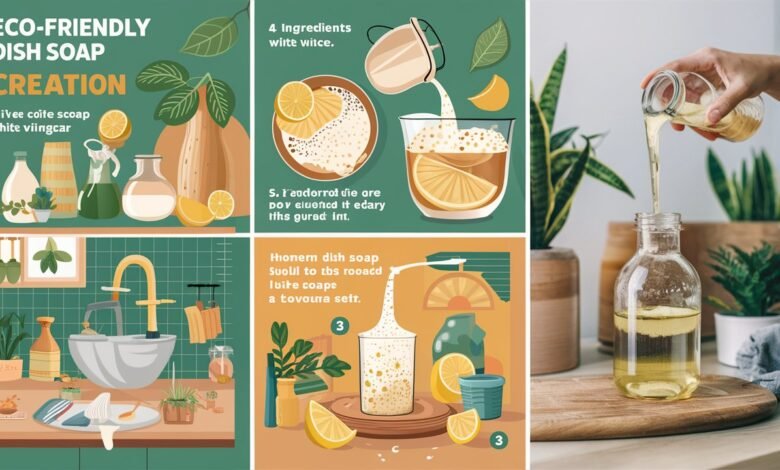
Introduction
In an era where sustainability and health-conscious living are paramount, creating your own dish soap is a small but impactful step toward reducing plastic waste and eliminating exposure to harsh chemicals. Commercial dish soaps often contain synthetic fragrances, phosphates, and preservatives that harm aquatic ecosystems and may irritate sensitive skin. By crafting your own dish soap, you gain control over the ingredients, ensuring a non-toxic, biodegradable formula that’s gentle on your hands and the planet. This guide will walk you through the process, from sourcing materials to customizing scents, empowering you to embrace a greener kitchen routine.
1. Why Make Your Own Dish Soap?
Homemade dish soap offers numerous advantages beyond cost savings. Conventional dishwashing liquids contribute to plastic pollution, with millions of bottles ending up in landfills annually. By reusing containers and opting for natural ingredients, you minimize waste. Additionally, many store-bought soaps contain surfactants like sodium lauryl sulfate (SLS), which can strip natural oils from your skin. DIY recipes prioritize mild, plant-based components like castile soap and coconut oil, which cleanse effectively without irritation. Environmentally, homemade soaps break down safely in water systems, reducing toxicity for marine life.
2. Essential Ingredients for Homemade Dish Soap
A successful DIY dish soap requires a blend of cleansing, thickening, and scent-enhancing ingredients. Castile soap, a vegetable oil-based soap, serves as the primary cleanser. Washing soda (sodium carbonate) boosts grease-cutting power, while vegetable glycerin adds viscosity and moisturizes hands. Essential oils like lemon, lavender, or tea tree provide natural fragrance and antibacterial properties. Optional additions include white vinegar for hard water mineral removal or salt to adjust consistency. Always choose organic, sustainably sourced ingredients to align with eco-friendly goals.
3. Step-by-Step Recipe for DIY Dish Soap
Note: This recipe yields a thick, gel-like soap suitable for handwashing dishes.
- Gather Supplies:
- 1 cup liquid castile soap
- ¼ cup washing soda
- 1 tbsp vegetable glycerin
- 10–15 drops essential oils
- 2 cups distilled water
- Heat-safe bowl and whisk
- Mix the Base:
Heat distilled water until warm (not boiling). Gradually whisk in washing soda until fully dissolved. Add castile soap and glycerin, stirring gently to avoid excessive suds. - Customize Scent and Texture:
Stir in essential oils. For a thicker consistency, refrigerate the mixture for 1–2 hours; it will gel as it cools. Adjust with salt (to thicken) or water (to thin) as needed. - Store Properly:
Pour into a reusable glass bottle or repurposed plastic dispenser. Label with the date and shake before each use, as natural separation may occur.
4. Benefits of Homemade Dish Soap Over Commercial Brands
Unlike mass-produced alternatives, homemade dish soap avoids synthetic additives and microplastics. It’s free from artificial dyes and parabens, making it ideal for households with children or pets. The formula is also highly customizable—add more washing soda for tough grease or lavender oil for a calming aroma. Economically, a single batch costs a fraction of premium eco-brands, and bulk ingredients can last months. Environmentally, you’ll reduce carbon footprints by cutting down on manufacturing and transportation emissions linked to commercial products.
5. Troubleshooting Common DIY Dish Soap Issues
Problem: Soap is too watery.
Solution: Add 1 tsp salt at a time while heating the mixture, or increase castile soap concentration.
Problem: Lack of suds.
Solution: Suds don’t equate to cleaning power, but if desired, add 1 tbsp coconut oil-based soap paste.
Problem: Residue on dishes.
Solution: Hard water may react with washing soda—add 1 tbsp vinegar to the mix or rinse dishes with a vinegar-water solution.
6. Customizing Your Dish Soap for Specific Needs
Tailor your soap to address unique preferences or challenges:
- Antibacterial Boost: Add tea tree or eucalyptus oil.
- Citrus Degreaser: Use lemon or orange essential oils.
- Sensitive Skin: Omit essential oils and add aloe vera gel.
- Septic-Safe: Ensure all ingredients are biodegradable (this recipe is septic-friendly!).
7. Storing and Using Your Homemade Dish Soap
Store the soap in a cool, dark place to prolong shelf life (up to 6 months). Use 1–2 tablespoons per sinkful of water, or apply directly to sponges. Avoid using in dishwashers, as the formula lacks enzymes required for machine cleaning. For stubborn stains, pre-soak dishes with a baking soda paste.
Conclusion
Crafting your own dish soap is a rewarding endeavor that aligns with eco-conscious values without sacrificing practicality. With simple ingredients and minimal effort, you’ll create a versatile cleaner that safeguards your health and the environment. As you refine your recipe, you’ll discover the joy of DIY living—one sudsy, sustainable dish at a time.
Frequently Asked Questions (FAQs)
Q1: Will homemade dish soap work in hard water?
Yes, but mineral buildup may require extra rinsing. Add 1 tbsp vinegar to the mixture or use a vinegar rinse cycle.
Q2: Can I use this soap in a dishwasher?
No. Dishwasher detergents require specific enzymes and low-sudsing formulas. This recipe is designed for handwashing.
Q3: Is homemade dish soap antibacterial?
Essential oils like tea tree or eucalyptus offer natural antibacterial properties, but for heavy sanitation, pair with a vinegar rinse.
Q4: How long does a batch last?
Up to 6 months if stored properly. Discard if mold appears or the scent fades.
Q5: Can I substitute baking soda for washing soda?
No—baking soda (sodium bicarbonate) lacks the grease-cutting strength of washing soda (sodium carbonate).
Q6: Is this soap safe for septic systems?
Yes! All ingredients are biodegradable and septic-friendly.
Embrace the shift to sustainable cleaning with this DIY dish soap recipe—your dishes, wallet, and planet will thank you!



